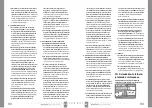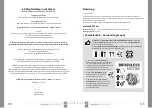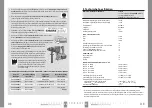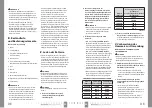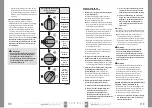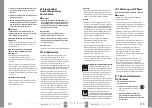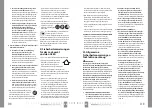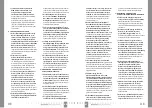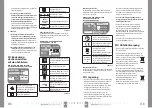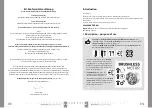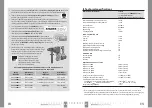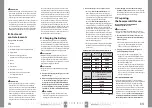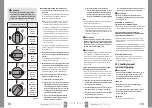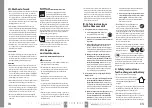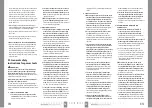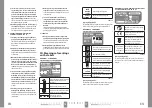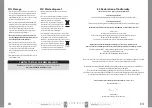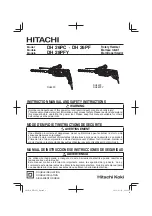
73
72
EN
EN
y
For warranty repairs, please contact the vendor from
whom you purchased the product and they will organi-
se repairs at an authorised service centre for the Extol®
brand. For a post warranty repair, please contact the
authorised service centre of the Extol® brand directly
(you will find the repair locations at the website at the
start of this user‘s manual).
IX. Safety instructions
for the hammer drill
1.
Safety instructions for all work activity
a) Use hearing protection.
Exposure to
noise may result in loss of hearing.
b) It is necessary to use the additional
handle. Loss of control may result in injuries
to persons.
c) Before using the power tool, it is necessary
to properly lean against it.
This power tool
generates a high output torque and without proper
leaning against the tool during operation, loss of con-
trol may result, which may lead to injury of persons.
d) When performing activities, where the
machining tool or the coupling part may
come into contact with hidden conduits or
its own power cord, hold the power tool by
the insulated holding surfaces.
In the event
that the machining tool comes into contact with
a „live“ conduit, the uninsulated metal parts of the
power tool will become live and may result in the
user suffering injury by electrical shock.
2) Safety instructions for using long drill bits in
hammer drills
a) Never use the power tool for higher rotation
speeds than the maximum rated rotation
speed of the drill bit.
At higher rotation speeds,
it is probable that the drill bit will bend if allowed to
rotate freely without being in contact with a work-
piece, which may lead to injuries to persons.
b) When starting to drill, it is always necessary
to have a low rotation speed and the tip
of the drill bit must be in contact with the
workpiece.
At higher rotation speeds, it is proba-
ble that the drill bit will bend if allowed to rotate
freely without being in contact with a workpiece,
which may lead to injuries to persons.
c) It is necessary to push only in the direction
of the drill bit and excessive pressure must
not be applied.
Drill bits may bend and may
break or may result in loss of control, which may
lead to injuries to persons.
y
When drilling into a material during which
dust is generated, e.g. when drilling into
wood, ensure the extraction of dust from the
environment by the use of a suitable industrial vacuum
cleaner by placing the vacuum cleaner nozzle to the dri-
lling location and, likewise, by using certified respirato-
ry tract protection with a sufficient level of protection.
Ensure ventilation of the area. Inhalation of dust is
damaging to health. Do not use a domestic vacuum cle-
aner for extracting the dust.
y
Furthermore, when working with the hammer drill, use
certified eye protection with a sufficient level of protec-
tion and suitable work clo-
thing and work gloves.
The power tool creates an electromagnetic
field during operation, which may negatively
affect the operation of active or passive medi-
cal implants (pacemakers) and threaten the life of the
user. Prior to using this power tool, ask a doctor or the
manufacturer of the implant, whether you may work with
this power tool.
X. Safety instructions
for the charger and battery
y
Read the user‘s manual before charging.
y
The charger is intended only for charging
indoors. It is necessary to protect it against
rain, high humidity and temperatures
over 40°C.
y
The charger is only intended for charging batteries from
the SHARE 20 V product line and must not be used for
charging other batteries or other purposes.
y
Prevent the charger from being used by persons
(including children) whose physical, sensory or mental
disability or incapacity or insufficient experience or
knowledge prevents them from safely using the appli-
VII. Method of work
y
Before starting work, make sure that there are no utility
lines, e.g. electrical, water, gas, steam, etc. in the chi-
selled/drilled material, since by damaging these utility
lines, injury, explosion or other material damage may
result. To find these utility lines, use a suitable metal
and electricity detector and compare the situation with
building plans where necessary.
y
Hold the hammer drill with both hands on the grip
surfaces of the front and rear handle while maintaining
a firm and stable body stance (fig. 7). The hammer drill
has a powerful action and may thus destabilise the user
and cause potential injury. Also this method of holding
the power tool by the plastic handles reduces the risk of
injury by electrical shock when a hidden electricity con-
duit is hit, which may come into contact with metal parts
of the power tool and cause injury by electrical shock.
y
If it makes sense, secure the workpiece using, for exam-
ple, a clamp or vice so that it cannot spring out and
potentially cause injuries.
CHISELLING
y
The principle of chiselling is based on the gradual destruc-
tion of material by the effect of impacts and insertion of
the wedge of the chisel, and thus it is necessary to perform
grooving and fluting gradually layer by layer.
DRILLING
y
When drilling holes into wall tiles and floor tiles (cera-
mics) do not use the impact drilling mode as this would
damage the glaze. To drill a hole into a ceramic tile, first
paste masking tape on to the surface in the shape of
a cross to limit the drill bit from slipping and damaging
the tile, and mark the drill location with a cross (fig. 8).
Start drilling in the location of the cross.
y
When drilling holes into metal, lubricate with a drill bit
coolant emulsion, lubricating paste or machine oil.
y
Before putting down the hammer drill, wait until the
work tool stops moving, otherwise a rotating work tool
may trip against something while being put down and
thereby result in loss of control over the power tool.
y
Never carry the hammer drill while it is running and
do not leave it without supervision while the battery is
connected.
INFORMATION
ABOUT THE BATTERY/RUNNING TIME
The battery is equipped with electronic
protection against full discharge, which
damages it, and thereby extends its lifespan.
This protection manifests its self by the power tool co-
ming to a sudden stop even when the power switch is in
the „On“ position. After setting the power switch to the
„Off“ position and then turning it on again, after a certain
time the power tool will start up again, however, it will
again stop suddenly. This is not a fault of the power tool or
battery, but rather serves as protection. For longer opera-
ting time of the power tool, it is necessary to purchase
a battery with a greater capacity.
The motor and the battery have electronic
protection against overloading, which disco-
nnects the power supply when excessive load
is detected, which manifests itself by the power tool
coming to a stop. This is not a fault of the power tool or
battery, but rather serves as protection.
VIII. Repairs
and maintenance
CLEANING, MAINTENANCE, REPAIRS
•
ATTENTION
y
Remove the battery from the hammer drill before per-
forming maintenance and cleaning.
y
Ensure that the SDS clamping head is free of stones,
construction dust or other abrasive materials created
during chiselling/drilling, since these damage the
clamping system.
y
Regularly inspect and keep the motor vents clean,
otherwise the motor may overheat as a result of insu-
fficient air flow.
y
To clean the surface of the hammer drill, use a damp
cloth dipped in, for example, soapy water. Ensure that
no water enters into the internal area of the hammer
drill.
y
Do not use organic solvents for cleaning, e.g. based on
acetone, abrasive cleaning agents or agents with oxida-
tion properties, since they would damage the surface of
the hammer drill.

